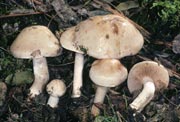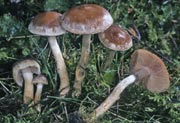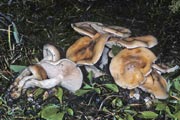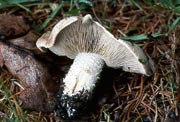
Kit Scates Barnhart

Kit Scates Barnhart

Kit Scates Barnhart

Paul Kroeger
Considerably more field work must be done before a comprehensive key can be written for Hebeloma in the Pacific Northwest. It has been said in jest that there are only four species: veiled Hebeloma, poison pie (Hebeloma crustuliniforme), scaly-stalked Hebeloma (Hebeloma sinapizans group), and sweet-smelling Hebeloma (Hebeloma sacchariolens). That is just to illustrate the difficulty of distinguishing members of the genus which David Arora calls “another faceless and featureless collection of brownish mushrooms”.
By 2019, considerable new research on Hebeloma had been carried out by Henry Beker and his colleagues in Europe and North America including the Pacific Northwest. A European monograph was published in 2016 as the fourteenth volume of the Fungi Europaei series. A North American monograph is planned, which will advance considerably the knowledge of Pacific Northwest species.
A monograph for the veiled Hebelomas was written by A.H. Smith et al. in 1983, The veiled species of Hebeloma in the western United States. The monograph describes more than 90 species of which about a third had collections examined from the Pacific Northwest. Most of the rest were described from Colorado and could occur in the Pacific Northwest. The monograph has now been made available at MykoWeb:
The veiled species of Hebeloma in the western United States and in somewhat less accessible form at the University of Michigan:
The veiled species of Hebeloma in the western United States
The keys it contains should be consulted for detailed work. They have been abstracted below to contain only the species that Smith et al. document from the Pacific Northwest, in this case defined as British Columbia, Washington, Oregon, and Idaho. Identification is based on microscopic features.
Species such as Hebeloma radicosoides and Hebeloma danicum are among the ammonia fungi, studied by Naohika Sagara and found to fruit through the application of ammonia or ammonia-releasing nitrogenous material (such as rotting carcasses) to soil. Because those particular fungi have root-like extensions they have the potential to fruit in response to underground human corpses (“corpse finders"). The occurrence of such fungi in the Pacific Northwest is not well proven.
Descriptions of the veiled species are found in the monograph mentioned above. Hebeloma crustuliniforme [group], Hebeloma sacchariolens [group], and the Hebeloma sinapizans group are well described by Arora (1986). A North American monograph is eagerly awaited.
Hebeloma crustuliniforme group Kit Scates Barnhart |
Hebeloma mesophaeum group Kit Scates Barnhart |
Hebeloma sacchariolens group Kit Scates Barnhart |
Hebeloma sinapizans group Paul Kroeger |
1a Veil present, usually fibrillose to cortinate (Subgenus Hebeloma)
................................................................................2
1b Veil absent (Subgenus Denudata)
................................................................................501
2a Spores in profile view bean-shaped to elliptic or ovate, the apex +/- rounded (Section Mesophaea)
................................................................................3
2b Spores +/- inequilateral in profile and narrowed to a blunt apex or apex +/- snoutlike (Section Hebeloma)
................................................................................4
3a Spores 10-15 um long or longer (Subsection Subviscidae)
................................................................................101
3b Spores 7-10 (11) um long (Subsection Mesophaeae)
................................................................................201
4a (2b) Pileus white to pallid or cream color (Subsection Pallidae)
................................................................................Hebeloma salmonense (may be a synonym of Hebeloma velutipes)
4b Pileus more highly colored when young than in above choice
................................................................................5
5a When fresh the odor fragrant to pungent-aromatic (Subsection Praeolidae)
................................................................................Hebeloma praeolidum
5b Not as above (the odor if present +/- pungent to radishlike)
................................................................................6
6a Spores 7-10(11) um long (Subsection Mesosporae)
................................................................................301
6b Spores (9) 10-15 um or longer (Subsection Magnisporae)
................................................................................401
101a (3a) Odor and taste of radish, lamellae pinkish gray, veil pallid
................................................................................Hebeloma vinaceogriseum (synonym of H. mesophaeum var. obscurum in Eberhardt et al. 2022)
101b Odor and taste not distinctive
................................................................................102
102a Odor and taste farinaceous, interior of stipe bay-red
................................................................................Hebeloma sterlingii (synonymized with Hebeloma excedens in Eberhardt et al. (2022)
102b Odor and taste not distinctive, stipe not splitting lengthwise, gregarious not caespitose
................................................................................Hebeloma ollaliense
201a (3b) Cuticle of pileus an ixotrichodermium rarely collapsing to an ixolattice (study young pilei) (Stirps Pseudostrophosum)
................................................................................202
201b Not as above (cuticle rarely an ixolattice in age)
................................................................................203
202a Cheilocystidia 40-70 x 7-12 x 2.3-5 um
................................................................................Hebeloma pseudostrophosum
202b Cheilocystidia 28-43 x 5-7 x 7-9 um
................................................................................Hebeloma alpinicola (may be same sp. as H. perigoense and H. nigromaculatum)
203a (201b) Pileus and/or gills staining dark brown to blackish on some basidiocarps in situ (Stirps Nigromaculatum)
................................................................................204
203b Not staining as above
................................................................................205
204a Veil whitish (pallid)
................................................................................Hebeloma nigromaculatum (may be same species as H. alpinicola and H. perigoense)
204b Veil (or at least outer layer) buff to pale tan
................................................................................Hebeloma angelesiense (H. pseudostrophosum may be the same species)
205a (203b) Stipe not darkening at base in age (Stirps Pascuense)
................................................................................Hebeloma perigoense (may be same species as H. alpinicola and H. nigromaculatum)
205b Stipe soon darkening in basal area at least (Stirps Mesophaeum)
................................................................................206
206a Odor and/or taste raphanoid
................................................................................207
206b Odor and/or taste not as above
................................................................................Hebeloma mesophaeum
207a Spores 7-9 x 4.5-5.5 um, veil copious
................................................................................Hebeloma strophosum var. strophosum
207b Spores 8-11 x 5-6 um
................................................................................208
208a Veil copious and remains long persistent on margin of pileus and/or stipe
................................................................................Hebeloma strophosum var. occidentale
208b Veil thin and scarcely leaving a zone of fibrils on the stipe
................................................................................Hebeloma mesophaeum
301a (6a) Stipe not darkening in lower part by maturity
................................................................................302
301b Stipe darkening (often slowly) from the base upward
................................................................................304
302a Taste bitter-farinaceous; pileus orange-brown when moist
................................................................................Hebeloma aurantiellum
302b Not as above
................................................................................303
303a Cheilocystidia 26-33 x 8-12 um
................................................................................Hebeloma immutabile
303b Cheilocystidia 40-67 x 4.5-7 um
................................................................................See Hebeloma fastibile
304a (301b) Spores 7-9 x 4-5 um
................................................................................Hebeloma olympianum
304b Spores larger
................................................................................305
305a Odor fragrant; cheilocystidia 27-41 x 8-11 um
................................................................................Hebeloma pinetorum
305b Not as above
................................................................................306
306a Cheilocystidia 18-26 x 3-4 um, many of them tibiiform
................................................................................Hebeloma subhepaticum
306b Cheilocystidia not as above (at least wider than 3-4 um)
................................................................................Hebeloma parcivelum
401a (6b) Stipe not staining or discoloring in the lower portion by late maturity (Stirps Coniferarum)
................................................................................402
401b Stipe soon darkening at base or lower portion, then upward
................................................................................404
402a Cheilocystidia fusoid-ventricose, the apices subcapitate; odor pungent
................................................................................Hebeloma pungens
402b Not as above
................................................................................403
403a Cheilocystidia (some of them) cylindric-subcapitate; pileus slimy viscid
................................................................................Hebeloma kelloggense
403b Not as above
................................................................................Hebeloma pseudofastibile
404a (401b) Spores dextrinoid (medium to dark reddish brown in Melzer’s (Stirps Kuehneri)
................................................................................405
404b Spores not dextrinoid, but in a mount a few may be found which become pale to +/- reddish brown in 30 minutes; (dried specimens are most reliable for this test) (Strips Oregonense)
................................................................................408
405a Spores 9-12 um long
................................................................................406
405b Spores 10-15 um or more long
................................................................................Hebeloma marginatulum
406a Odor and taste mild or odor weakly pungent
................................................................................407
406b Odor and taste raphanoid
................................................................................Hebeloma pseudofastibile
407a Veil whitish
................................................................................Hebeloma occidentale (synonymized with H. palustre in Eberhardt et al. 2022)
407b Veil grayish
................................................................................Hebeloma obscurum (synonymized with H. palustre in Eberhardt et al. 2022)
408a (404b) Taste and usually the odor of the crushed context raphanoid
................................................................................409
408b Not as above (odor +/- pungent in some and in others the taste farinaceous to bitter or at least not raphanoid)
................................................................................413
409a Spores 9-12 um long
................................................................................410
409b Spores (10) 12-15 um long
................................................................................412
410a Spores 9-12 x 5-6.5 um
................................................................................Hebeloma fastibile (may be nomen dubium et confusum)
410b Cheilocystidia not as above (at least wider than 3-4 um)
................................................................................411
411a Veil remnants on stem white
................................................................................Hebeloma latisporum
411b Veil remnants pale ochraceous
................................................................................Hebeloma idahoense (synonymized with H. palustre in Eberhardt et al. 2022)
412a (409b) Spores distinctly rough under a high-dry objective
................................................................................Hebeloma stanleyense (synonymized with H. palustre in Eberhardt et al. 2022)
412b Spores appearing smooth under a high-dry objective or a 1.25 NA objective
................................................................................Hebeloma oregonense
413a (408b) Stipe staining yellow where injured
................................................................................Hebeloma lutescentipes (synonymized with H. palustre in Eberhardt et al. 2022)
413b Stipe not staining yellow where handled
................................................................................Hebeloma oregonense
501a (1b) Strong odor sweet and aromatic, like burnt sugar, caramel, fruit candy, or orange blossom
................................................................................Hebeloma sacchariolens
501b Not as above, odor often radish-like
................................................................................502
502a Pileus 4-13(20) cm across, typically brown to cinnamon, dark reddish brown, ocher-brown, or pinkish tan, often shaded with gray or overlaid with a pallid sheen toward margin, which is at first minutely cottony; stipe 1-3 cm thick, with distinct pallid to brownish flakes or protruding scales (Arora)
................................................................................Hebeloma sinapizans group
502b Not as above
................................................................................Other groups including Section Velutipes (H. velutipes etc.) and Section Denudata (H. crustuliniforme group, H. cavipes, H. hiemale, etc.)
- END -